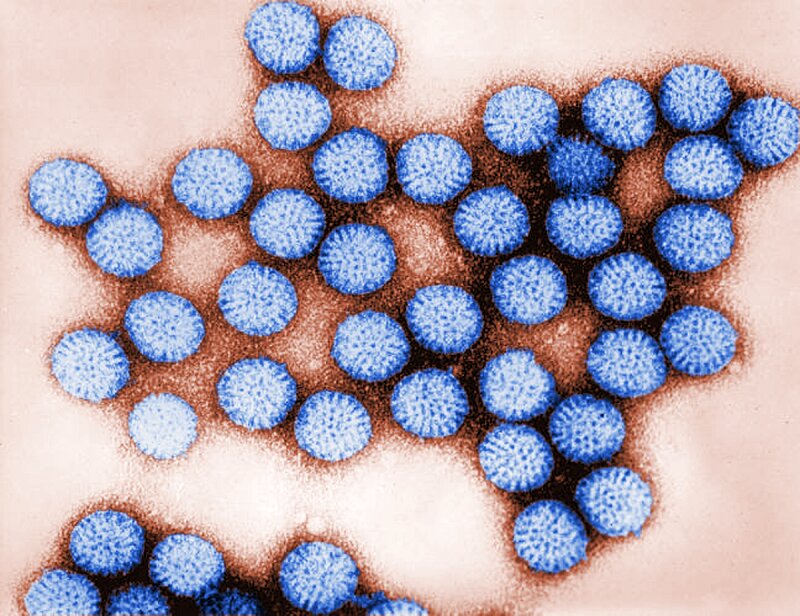
Transmission electron micrograph (TEM) of intact rotavirus particles Image: CDC
Rotavirus is a major cause of diarrhea and vomiting, especially in children, that results in approximately 128,000 deaths annually.
The virus triggers the disease by infecting enterocyte cells in the small intestine, but only a fraction of the susceptible cells has the virus.
In the mid-90s, scientists proposed that the small portion of infected cells promotes severe disease by sending out signals that disrupt the normal function of neighboring uninfected cells, but the nature of the signal has remained a mystery.
In the current study published in the journal Science, a team led by researchers at Baylor College of Medicine discovered that rotavirus-infected cells release signaling molecules, identified as adenosine diphosphate (ADP), which binds its cellular receptor P2Y1 on neighboring cells. Activating P2Y1 by ADP results in signals called intercellular calcium waves in these uninfected cells. Disrupting ADP binding to its receptor reduced the severity of diarrhea in a mouse model of the disease, suggesting that targeting the P2Y1 may be an effective strategy to control viral diarrhea in human populations.
“In our previous studies using fluorescent calcium sensors and time-lapse imaging, we discovered that rotavirus-infected cells display aberrant calcium signals that we can visualize as bright pulses of intercellular calcium waves that radiate from the infected cells,” said corresponding author Dr. Joseph Hyser, assistant professor of virology and microbiology and member of the Alkek Center for Metagenomic and Microbiome Research at Baylor. “Calcium signaling was known to be associated with various aspects of rotavirus infection and our work revealed the dynamic nature of the alterations induced by rotavirus.”
In the current study, the researchers conducted the experiments using a lower dose of the virus and noticed that it was not just the virus-infected cells that showed dynamic calcium signaling, but also the adjacent uninfected cells surrounding the infected cells produced pulses of calcium waves that were coordinated with those of the infected cells.
This observation suggested that the infected cells could be triggering intercellular calcium waves in the uninfected cells.
The researchers connected their observation to a concept proposed in the mid-90s suggesting that rotavirus-infected cells send signals to neighboring uninfected cells that disrupt their function, promoting diarrhea and vomiting.
“Our videos of live fluorescent microscopy showing intercellular calcium wave signaling in both rotavirus-infected and uninfected cells provided an unprecedented means to investigate the nature of the proposed signal, which had not been identified,” said first author Dr. Alexandra L. Chang-Graham, an M.D./Ph.D. student in the Medical Scientist Training Program who completed her Ph.D. thesis working in the Hyser lab.
Finding the signal
Chang-Graham, Hyser and their colleagues worked with three different laboratory models to identify the signal that triggers intercellular calcium waves on uninfected cells. They used a monkey kidney cell line commonly used to study rotavirus. They also worked with human intestinal enteroids, a cultivation system that recapitulates many of the characteristics of the human infection and a neonatal mouse model of rotavirus infection and diarrhea.
Their studies showed that suspected triggers of calcium waves, such as prostaglandin E2 and nitric oxide, did not elicit a calcium response. Then they tested ATP and ADP, known mediators of calcium signaling that had not been previously associated with rotavirus infection. They found that rotavirus-infected cells triggered intercellular calcium waves by releasing ADP that binds to its receptor, P2Y1, on uninfected neighboring cells. Knocking out the P2Y1 gene, which prevents ADP from signaling, reduced intercellular calcium waves.
“Across the three model systems we consistently found evidence that rotavirus-infected cells signal uninfected cells with ADP and that this contributes to the severity of the disease,” Chang-Graham said. “We consider it paradigm shifting that the actual signal, ADP, was not even on the radar before.”
ADP signaling is involved in triggering severe rotavirus symptoms
Further studies revealed previously unknown roles of ADP on rotavirus infection and replication, shining a spotlight on ADP as an important trigger of the multiple factors involved in severe diarrhea and vomiting caused by rotavirus.
For instance, the researchers found evidence that ADP signaling increases rotavirus infection, the expression of inflammatory cytokine IL1-alpha and the secretion of serotonin, an inducer of diarrhea.
ADP signaling also increases the expression of enzymes that produce prostaglandin and nitric oxide, potentially causing the increases in those compounds observed in rotavirus infection. Preventing ADP signaling and intercellular calcium waves reduced the production of the compounds mentioned above.
“Finally, we determined that inhibiting the P2Y1 receptor reduced the severity of rotavirus-induced diarrhea in a mouse model,” Chang-Graham said. “Using intercellular calcium waves, rotavirus amplifies its ability to cause disease beyond the cells it directly infects. This is the first virus identified to activate ADP-mediated intercellular calcium waves. This may be a strategy that other viruses also use to cause disease in their hosts.”
“Our findings add a new and very potent signaling pathway into the causative mechanisms of rotavirus diarrhea,” Hyser said. “In terms of treatment, this is exciting because currently some drugs targeting P2Y1 are undergoing preclinical testing as anticlotting drugs. It’s possible that such drugs could be repurposed, if proven to be safe for children, to be used to treat diarrhea caused by rotavirus infection.”
Source: Baylor College of Medicine
Original study: DOI: 10.1126/science.abc3621
Sign up for the QuackTrack.org newsletter below!













